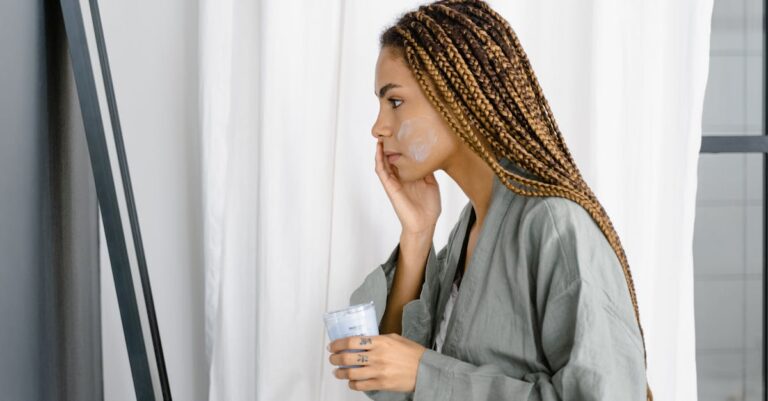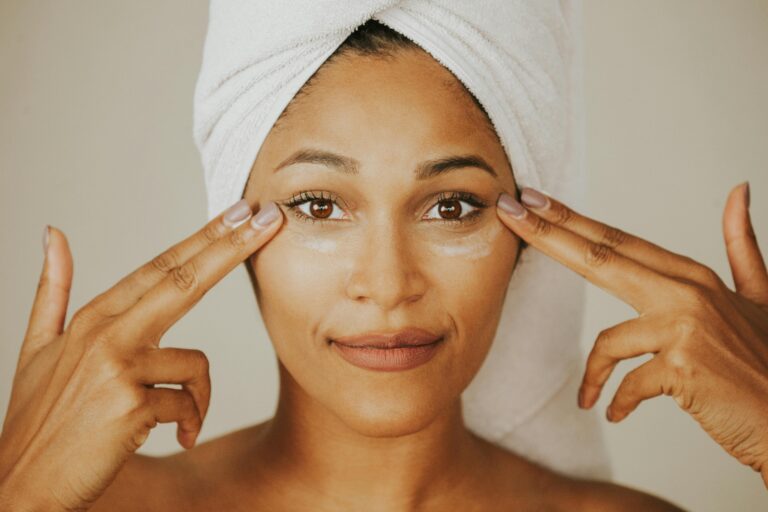A glowing, radiant complexion is often associated with healthy skin—and for good reason. Whether you’re battling dullness, uneven tone, or dark spots, brightening serums have emerged as a go-to solution in the skincare world. These potent formulations are designed to target pigmentation issues, boost luminosity, and leave the skin looking refreshed and revitalized.
But with a sea of products and ingredients out there, how do you know which serum is right for you? And more importantly, how do you use it effectively to get the glow you’re after?
In this guide, we’ll walk you through everything you need to know about brightening serums: what they are, how they work, what ingredients to look for, and how to incorporate them into your skincare routine for visible, long-lasting results.
What Are Brightening Serums?
Brightening serums are concentrated skincare products formulated to enhance the skin’s natural radiance and reduce visible signs of dullness, discoloration, and uneven tone. Unlike moisturizers, which primarily focus on hydration, or exfoliants that slough off dead skin cells, brightening serums penetrate deeper into the skin to target pigmentation and boost clarity from within.
These serums are typically lightweight and packed with active ingredients such as antioxidants, peptides, and botanical extracts that work together to:
- Fade dark spots and hyperpigmentation
- Even out skin tone
- Promote a healthy, luminous glow
They’re often used as part of a targeted skincare routine to correct sun damage, post-inflammatory marks (like acne scars), and the general loss of brightness that can occur with aging or environmental stress.
Brightening serums come in various forms—water-based liquids, gel-like formulations, or even oil-infused hybrids—but their common goal is to illuminate and clarify the skin without harsh bleaching effects.
How Brightening Serums Work
Brightening serums are more than just glow-enhancers—they’re formulated with science-backed ingredients that work at the cellular level to improve skin tone and texture. Here’s how they get the job done:
1. Inhibiting Melanin Production
Melanin is the pigment responsible for the color of your skin, but when overproduced (due to sun exposure, inflammation, or hormones), it can lead to dark spots and uneven skin tone. Many brightening ingredients, like vitamin C, alpha arbutin, and kojic acid, work by inhibiting tyrosinase, the enzyme that triggers melanin production. This helps prevent new spots from forming while gradually fading existing ones.
2. Accelerating Cell Turnover
Dead skin cells can accumulate on the surface of your skin, making it look dull and lackluster. Ingredients like glycolic acid or retinoids (sometimes included in brightening serums or used alongside them) promote faster cell turnover, revealing fresher, more radiant skin underneath.
3. Boosting Antioxidant Protection
Brightening serums often include antioxidants such as vitamin C, ferulic acid, and resveratrol to neutralize free radicals caused by UV exposure and pollution. This helps prevent oxidative stress—a key contributor to skin discoloration and dullness.
4. Hydrating and Smoothing
Hydration plays a subtle but important role in brightness. Ingredients like hyaluronic acid and glycerin plump the skin and improve texture, which in turn reflects light better, giving your skin that healthy, dewy glow.
5. Reducing Inflammation
Chronic inflammation from acne, eczema, or other skin concerns can lead to post-inflammatory hyperpigmentation. Anti-inflammatory ingredients such as niacinamide or licorice root extract help soothe the skin, which not only calms irritation but also helps even out the complexion over time.
Key Ingredients to Look For
Choosing the right brightening serum often comes down to understanding the ingredients. These active components are what deliver the glow-up. Below are some of the most effective and well-researched ingredients commonly found in brightening serums:
1. Vitamin C (Ascorbic Acid)
- What it does: A powerful antioxidant that fades pigmentation, boosts collagen production, and brightens overall tone.
- Why it’s great: Works on both prevention and correction of sun-induced discoloration.
- Tip: Look for stabilized forms (like sodium ascorbyl phosphate or tetrahexyldecyl ascorbate) if you have sensitive skin.
2. Niacinamide (Vitamin B3)
- What it does: Reduces inflammation, fades dark spots, and strengthens the skin barrier.
- Why it’s great: Versatile, gentle, and effective for almost all skin types—especially sensitive or acne-prone skin.
- Bonus: Helps regulate oil production and minimize pores.
3. Alpha Arbutin
- What it does: Inhibits melanin formation, helping to fade hyperpigmentation and even skin tone.
- Why it’s great: A gentler alternative to hydroquinone with fewer side effects.
4. Licorice Root Extract
- What it does: Calms irritation and helps lighten dark spots by reducing melanin synthesis.
- Why it’s great: Soothing and effective, especially for red or inflamed skin.
5. Kojic Acid
- What it does: A byproduct of rice fermentation that helps lighten sun damage, age spots, and scars.
- Why it’s great: Often used in professional treatments for pigmentation, but may cause irritation in high doses.
6. Tranexamic Acid
- What it does: Targets stubborn pigmentation (like melasma) by reducing inflammation and blocking UV-triggered pigment production.
- Why it’s great: Works well when layered with vitamin C or niacinamide for enhanced effects.
7. Azelaic Acid
- What it does: Fights acne, reduces redness, and fades dark spots.
- Why it’s great: Ideal for rosacea-prone or acneic skin types dealing with discoloration.
Quick Comparison Table (optional visual addition)
| Ingredient | Brightens | Anti-Inflammatory | Good for Sensitive Skin | Fades Spots |
|---|---|---|---|---|
| Vitamin C | ✅ | ✅ | ⚠️ (depends on form) | ✅ |
| Niacinamide | ✅ | ✅ | ✅ | ✅ |
| Alpha Arbutin | ✅ | ⚫ | ✅ | ✅ |
| Licorice Root | ✅ | ✅ | ✅ | ✅ |
| Kojic Acid | ✅ | ⚫ | ⚠️ | ✅ |
| Tranexamic Acid | ✅ | ✅ | ✅ | ✅ |
| Azelaic Acid | ✅ | ✅ | ✅ | ✅ |
Choosing the Right Serum for Your Skin Type
Not all brightening serums are one-size-fits-all. Your skin type plays a major role in how your skin reacts to certain ingredients. Choosing a serum tailored to your skin’s needs will give you better results and reduce the risk of irritation.
For Oily or Acne-Prone Skin
Best Ingredients: Niacinamide, azelaic acid, vitamin C (in water-based formulas), licorice root
What to Look For:
- Oil-free or gel-based serums
- Non-comedogenic labeling
- Lightweight, fast-absorbing textures
Avoid: Heavy oils, pore-clogging ingredients, overly thick or occlusive formulas
Pro Tip: Azelaic acid does double duty—it fades dark spots and fights acne-causing bacteria.
For Dry Skin
Best Ingredients: Vitamin C (in oil-based or creamy formulas), hyaluronic acid, alpha arbutin, licorice root
What to Look For:
- Hydrating serums with glycerin or squalane
- Creamier textures that lock in moisture
- Formulas with fewer drying agents like alcohol
Pro Tip: Layer a brightening serum with a rich moisturizer to seal in hydration and amplify glow.
For Sensitive Skin
Best Ingredients: Niacinamide, licorice root, tranexamic acid (low concentration), azelaic acid
What to Look For:
- Fragrance-free, alcohol-free formulas
- Lower concentrations of actives
- Minimal ingredient lists
Avoid: High-strength acids (like glycolic or kojic acid), unstable forms of vitamin C (like pure ascorbic acid)
Pro Tip: Always patch test before applying to your full face—especially when trying actives for the first time.
For Combination or Normal Skin
Best Ingredients: Most brightening agents can work here—vitamin C, niacinamide, alpha arbutin, etc.
What to Look For:
- Balanced formulations that hydrate without clogging pores
- Dual-purpose ingredients (e.g., vitamin C + hyaluronic acid)
- Lightweight yet nourishing textures
Pro Tip: You can alternate serums or apply them to targeted areas based on what your skin needs.
Bonus: Consider Your Concerns
- Hyperpigmentation or Melasma? Look into tranexamic acid + alpha arbutin.
- Post-acne marks? Niacinamide + azelaic acid can be powerful.
- Dullness? Vitamin C is the classic go-to.
How to Use Brightening Serums Effectively
Using a brightening serum correctly can make all the difference between a subtle glow and serious skin transformation. Here’s how to get the most out of your product:
Step-by-Step Application Guide
- Cleanse
Start with a gentle cleanser to remove dirt, oil, and impurities. A clean canvas helps your serum penetrate more effectively. - Tone (Optional)
Apply a hydrating or pH-balancing toner to prep the skin and help with better absorption. - Apply the Serum
Dispense a pea-sized amount and gently pat (not rub) it into your face. Focus on areas with dark spots, dullness, or uneven tone. - Moisturize
Lock in the serum’s active ingredients with a nourishing moisturizer to seal hydration and prevent transepidermal water loss. - Sunscreen (Morning Use Only)
If using your serum in the morning, follow with a broad-spectrum SPF 30+. This step is non-negotiable—many brightening ingredients make your skin more sensitive to the sun.
When to Use Brightening Serums
- Morning: Ideal for antioxidants like vitamin C and niacinamide to protect against environmental damage.
- Evening: Best for ingredients like alpha arbutin, kojic acid, or tranexamic acid that work overnight to repair and brighten.
You can use most brightening serums once or twice daily, depending on their concentration and your skin’s tolerance.
How to Layer with Other Products
- Don’t mix: Avoid layering vitamin C with benzoyl peroxide or strong exfoliating acids unless a product is specifically formulated for that.
- Do mix: Niacinamide plays well with most ingredients, including vitamin C and retinol.
- Wait time: Give your serum a few minutes to absorb before layering other products.
Pro Tips for Better Results
- Be consistent: Use the serum daily for 4–8 weeks to start seeing real change.
- Store it right: Keep vitamin C serums in a cool, dark place to prevent oxidation.
- Don’t overdo it: More product or more frequency won’t get faster results—stick to the recommended usage.
Common Mistakes to Avoid
Even the most potent brightening serum can fall short if it’s not used correctly—or worse, it can irritate your skin. Here are the most common missteps people make and how to avoid them:
1. Skipping Sunscreen
Using a brightening serum without daily sun protection is like trying to mop up a spill while the tap is still running. Many brightening ingredients make your skin more sensitive to UV rays, and sun exposure can undo all the progress you’ve made.
✅ Fix it: Always apply a broad-spectrum SPF 30 or higher during the day—especially if your serum contains vitamin C, arbutin, or acids.
2. Overusing Active Ingredients
More is not better. Layering multiple strong actives (like vitamin C, AHAs, BHAs, and retinol) can lead to irritation, dryness, or breakouts.
✅ Fix it: Stick to one or two actives at a time. Introduce new ingredients gradually, and monitor how your skin reacts.
3. Not Being Consistent
Brightening takes time and regular use. Many people expect instant results and give up too soon.
✅ Fix it: Commit to daily use for at least 4–8 weeks. Track your skin’s progress with photos if needed.
4. Ignoring Ingredient Conflicts
Some ingredients don’t play nice together and can either cancel each other out or cause irritation.
⚠️ Examples:
- Vitamin C + benzoyl peroxide (can oxidize vitamin C)
- Vitamin C + AHAs/BHAs (may cause sensitivity)
- Niacinamide + vitamin C (fine in most modern formulas, but watch for irritation in DIY routines)
✅ Fix it: Research before mixing—or choose a well-formulated serum that combines actives safely.
5. Using Expired or Oxidized Products
Especially true for vitamin C serums, which can oxidize and lose potency quickly.
✅ Fix it: Check expiration dates and store in a cool, dark place. If your serum has turned orange or brown (and it wasn’t originally), it’s time to toss it.
6. Applying on Dirty or Damp Skin (at the Wrong Time)
Applying serum to unwashed skin traps in dirt and oil. On the flip side, some actives can be too strong for damp skin and cause irritation.
✅ Fix it: Apply on clean, slightly dry or towel-dried skin—unless the instructions specifically say to use on damp skin (like with hyaluronic acid).
7. Forgetting to Moisturize After
Brightening serums aren’t moisturizers. Skipping hydration can leave your skin vulnerable and decrease effectiveness.
✅ Fix it: Always follow up with a moisturizer to help your skin recover and seal in active ingredients.
Before & After: Realistic Expectations
We all love a dramatic “before and after” shot, but when it comes to brightening serums, results are usually gradual and depend on consistency, the ingredients used, and your individual skin concerns. Setting realistic expectations helps you stay motivated and avoid disappointment.
What to Expect in the First Few Weeks
- Week 1–2:
- Your skin may feel smoother and slightly more hydrated.
- Dullness may start to diminish slightly, but pigmentation likely won’t change yet.
- Some may experience purging or minor breakouts, especially if using active ingredients like acids or retinoids for the first time.
- Week 3–4:
- Skin tone begins to even out subtly.
- Early signs of hyperpigmentation (like recent acne scars) may start to fade.
- Overall complexion looks a bit more “awake” and luminous.
- Week 5–8:
- Noticeable improvement in brightness, especially in areas affected by dullness or mild discoloration.
- Dark spots continue to fade with consistent use.
- Skin texture is smoother and more refined.
What “Radiant” Really Means
Radiance doesn’t necessarily mean blinding shine—it means:
- Even skin tone
- Fewer dark spots
- A healthy, hydrated glow
- Skin that reflects light well due to improved texture and clarity
Factors That Affect Results
- Severity of discoloration (deep melasma vs. mild post-acne marks)
- Skin type & sensitivity
- Consistency in usage
- Sun protection habits
- Overall skincare routine (exfoliation, hydration, etc.)
Conclusion
Bright, radiant skin isn’t just about luck—it’s about consistency, smart ingredients, and taking the time to understand what your skin truly needs. Brightening serums can be a game-changer in your skincare routine, helping to fade dark spots, correct dullness, and restore your natural glow.
But remember: no product works overnight. Patience, proper application, and diligent sun protection are key to achieving the glow you’re after. Choose a serum that suits your skin type, follow a solid routine, and give it time—your skin will thank you with a luminous, even-toned complexion.
Your glow-up is a few drops away. ✨
FAQ Section
Q: Can I use brightening serums every day?
Yes, most brightening serums are safe for daily use—some even twice daily. Just start slowly if you’re new to active ingredients and monitor your skin’s response.
Q: Are brightening serums safe for sensitive skin?
Absolutely, but go for gentler ingredients like niacinamide, licorice root, or azelaic acid. Avoid high concentrations of acids or pure vitamin C at first.
Q: Do brightening serums work for all skin tones?
Yes! These serums are designed to even out skin tone, not lighten skin color. They’re effective across all skin tones and can help with hyperpigmentation, acne marks, and dullness.
Q: How long before I see results?
Most people notice improvements in 4–8 weeks with consistent use. Deeper pigmentation may take longer to fade.
Q: Can I use multiple brightening serums together?
You can, but be cautious. Start with one, then layer or alternate if your skin tolerates it well. Watch out for ingredient conflicts (like strong acids with vitamin C).




